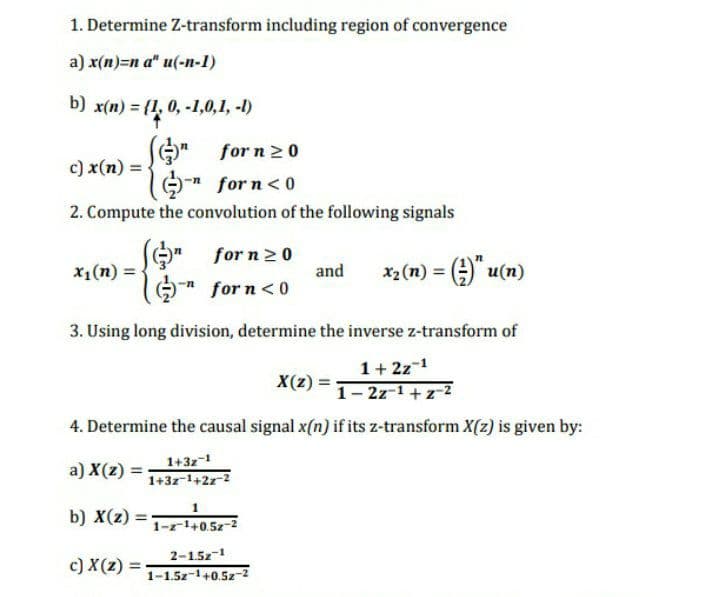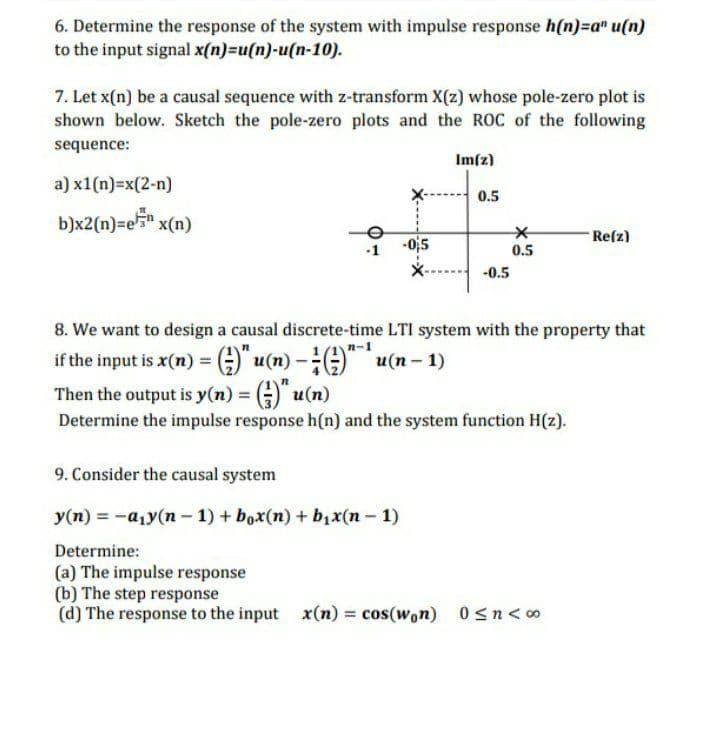Linear Algebra: A Modern Introduction
4th Edition
ISBN:9781285463247
Author:David Poole
Publisher:David Poole
Chapter4: Eigenvalues And Eigenvectors
Section4.6: Applications And The Perron-frobenius Theorem
Problem 17EQ
Related questions
Question

Transcribed Image Text:1. Determine Z-transform including region of convergence
a) x(n)=n a" u(-n-1)
b) x(n) = {1, 0, -1,0,1, -1)
(G)" for n 2 0
n for n<0
c) x(n) =
2. Compute the convolution of the following signals
for n20
and
X1(n) =
* for n<0
(u)n O = (u) x
3. Using long division, determine the inverse z-transform of
1+ 2z-1
X(z)
1- 2z-1 + z-2
4. Determine the causal signal x(n) if its z-transform X(z) is given by:
a) X(z) =
1+3z-1
1+3z-1+2z-2
b) X(z)
1-r1+0.5z-2
c) X(z) =
2-15z-1
%3D
1-1.5z-1+0.5z-2z

Transcribed Image Text:6. Determine the response of the system with impulse response h(n)=a" u(n)
to the input signal x(n)=u(n)-u(n-10).
7. Let x(n) be a causal sequence with z-transform X(z) whose pole-zero plot is
shown below. Sketch the pole-zero plots and the ROC of the following
sequence:
Im[z)
a) x1(n)=x(2-n)
0.5
b)x2(n)=e5* x(n)
Re(z)
-Oj5
0.5
-0.5
8. We want to design a causal discrete-time LTI system with the property that
if the input is x(n) =;)" u(n) -)" u(n - 1)
Then the output is y(n) = G)" u(n)
Determine the impulse response h(n) and the system function H(z).
9. Consider the causal system
y(n) = -a1y(n – 1) + box(n) + b,x(n- 1)
Determine:
(a) The impulse response
(b) The step response
(d) The response to the input x(n) = cos(won) 0sn<o
Expert Solution
This question has been solved!
Explore an expertly crafted, step-by-step solution for a thorough understanding of key concepts.
This is a popular solution!
Trending now
This is a popular solution!
Step by step
Solved in 2 steps with 2 images

Knowledge Booster
Learn more about
Need a deep-dive on the concept behind this application? Look no further. Learn more about this topic, calculus and related others by exploring similar questions and additional content below.Recommended textbooks for you

Linear Algebra: A Modern Introduction
Algebra
ISBN:
9781285463247
Author:
David Poole
Publisher:
Cengage Learning

Linear Algebra: A Modern Introduction
Algebra
ISBN:
9781285463247
Author:
David Poole
Publisher:
Cengage Learning